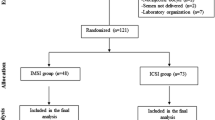Abstract
Purpose
The objective of this prospective, single center study was to develop a personalized training scheme for intracytoplasmic sperm injection (ICSI) through the use of learning curve-cumulative summation (LC-CUSUM), which allows to tailor training to the trainee performance, and to validate it against the performance of experienced embryologists.
Methods
Five trainees microinjected latex microspheres (LM) into vitro matured oocytes. A microinjection was considered successful when the oocyte did not lyse in the 24 h following the injection.
Results
Each trainee became proficient at ICSI after a variable number of injections, ranging from 35 to 80. Trainees that achieved proficiency went on to perform ICSI with human gametes in a clinical setting with proficiency comparable to that of experienced embryologists.
Conclusions
We show that LC-CUSUM based personalized ICSI training is feasible and allows trainees to be as proficient as trained embryologists when treating actual patients.


Similar content being viewed by others
References
CDC. ART Trends 2002–2011. Centers for Diseases Control and Prevention. 2015. http://www.cdc.gov/art/ART2011/section5.htm.
Kupka MS, Ferraretti AP, de Mouzon J, Erb K, D’Hooghe T, Castilla JA, et al. Assisted reproductive technology in Europe, 2010: results generated from European registers by ESHREdagger. Hum Reprod. 2014;29(10):2099–113. doi:10.1093/humrep/deu175.
Gvakharia MO, Lipshultz LI, Lamb DJ. Human sperm microinjection into hamster oocytes: a new tool for training and evaluation of the technical proficiency of intracytoplasmic sperm injection. Fertil Steril. 2000;73(2):395–401.
Heng BC. Proposed ethical guidelines and legislative framework for permitting gestational surrogacy in Singapore. Reprod Biomed Online. 2007;15 Suppl 1:7–11.
Biau DJ, Porcher R. A method for monitoring a process from an out of control to an in control state: application to the learning curve. Stat Med. 2010;29(18):1900–9. doi:10.1002/sim.3947.
Biau DJ, Williams SM, Schlup MM, Nizard RS, Porcher R. Quantitative and individualized assessment of the learning curve using LC-CUSUM. Br J Surg. 2008;95(7):925–9. doi:10.1002/bjs.6056.
Rodriguez A, Guillen JJ, Lopez MJ, Vassena R, Coll O, Vernaeve V. Learning curves in 3-dimensional sonographic follicle monitoring during controlled ovarian stimulation. J Ultrasound Med. 2014;33(4):649–55. doi:10.7863/ultra.33.4.649.
Dessolle L, Leperlier F, Biau DJ, Freour T, Barriere P. Proficiency in oocyte retrieval assessed by the learning curve cumulative summation test. Reprod Biomed Online. 2014;29(2):187–92. doi:10.1016/j.rbmo.2014.03.016.
Dessolle L, Biau DJ, de Larouziere V, Ravel C, Antoine JM, Darai E, et al. Learning curve of vitrification assessed by cumulative summation test for learning curve (LC-CUSUM). Fertil Steril. 2009;92(3):943–5. doi:10.1016/j.fertnstert.2009.01.133.
Dessolle L, Freour T, Barriere P, Jean M, Ravel C, Darai E, et al. How soon can I be proficient in embryo transfer? Lessons from the cumulative summation test for learning curve (LC-CUSUM). Hum Reprod. 2010;25(2):380–6. doi:10.1093/humrep/dep391.
Lopez MJ, Garcia D, Rodriguez A, Colodron M, Vassena R, Vernaeve V. Individualized embryo transfer training: timing and performance. Hum Reprod. 2014;29(7):1432–7. doi:10.1093/humrep/deu080.
Kovacic B, Plas C, Woodward BJ, Verheyen G, Prados FJ, Hreinsson J, et al. The educational and professional status of clinical embryology and clinical embryologists in Europedagger. Hum Reprod. 2015;30(8):1755–62. doi:10.1093/humrep/dev118.
Braga DP, Figueira Rde C, Rodrigues D, Madaschi C, Pasqualotto FF, Iaconelli Jr A, et al. Prognostic value of meiotic spindle imaging on fertilization rate and embryo development in in vitro-matured human oocytes. Fertil Steril. 2008;90(2):429–33. doi:10.1016/j.fertnstert.2007.06.088.
Van den Bergh M, Bertrand E, Englert Y. Intracytoplasmic single sperm injection: preclinical training and first clinical results. J Assist Reprod Genet. 1994;11(6):289–94.
Scott Jr RT, Hong KH, Werner MD, Forman EJ, Ruiz A, Cheng MC, et al. Embryology training for reproductive endocrine fellows in the clinical human embryology laboratory. J Assist Reprod Genet. 2014;31(4):385–91. doi:10.1007/s10815-014-0189-0.
Acknowledgments
The authors wish to thank Francesc Figueras for statistical support, Montserrat Barragán for help with figures composition, and the trainees for their participation in the study.
Author information
Authors and Affiliations
Corresponding author
Ethics declarations
All procedures performed in studies involving human participants were in accordance with the ethical standards of the institutional and/or national research committee and with the 1964 Helsinki Declaration and its later amendments or comparable ethical standards. Informed consent was obtained from all individual participants included in the study.
Conflict of interest
The authors declare that they have no conflict of interest.
Additional information
Capsule A personalized training scheme for intracytoplasmic sperm injection (ICSI) through the use of learning curve-cumulative summation (LC-CUSUM) has been developed and evaluated to ensure that trainees exiting the program are as proficient at ICSI as trained embryologists.
Rights and permissions
About this article
Cite this article
Durban, M., García, D., Obradors, A. et al. Are we ready to inject? Individualized LC-CUSUM training in ICSI. J Assist Reprod Genet 33, 1009–1015 (2016). https://doi.org/10.1007/s10815-016-0686-4
Received:
Accepted:
Published:
Issue Date:
DOI: https://doi.org/10.1007/s10815-016-0686-4




